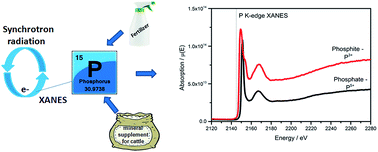Determination and speciation of phosphorus in fertilizers and mineral supplements for cattle by X-ray absorption near-edge structure spectroscopy: a simple nondestructive method†
Abstract
X-ray absorption near-edge structure (XANES) spectroscopy is an excellent analytical tool for the determination of the direct speciation of phosphorus in complex matrices as agricultural inputs. The use of linear combination fitting (LCF), principal component analysis (PCA) and partial least squares (PLS) enabled the development of a simple nondestructive method for the quantitative determination of different species of phosphorus in fertilizers and mineral supplements for cattle. The samples were classified into three classes using PCA: the samples containing phosphite, the samples containing phosphate and the samples containing both these species. The LCF is an interesting strategy for the qualitative and quantitative analyses of chemical species by XANES spectroscopy. Using LCF, the trueness of the phosphite and phosphate species added to the samples was found to be in the range of 96–113%. The strong matrix effects in the mechanism of X-ray absorption for P K-edge XANES spectroscopy prevented the determination of the phosphorus species in the fertilizers (trueness was in the range of 65–121%) and mineral supplements for cattle (trueness was in the range of 12–48%) using the PLS models.



 Please wait while we load your content...
Please wait while we load your content...